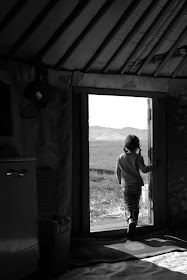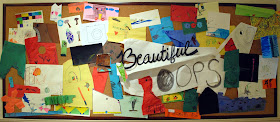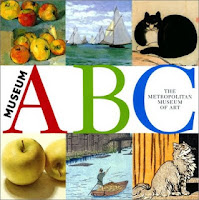If you want to see the article in the e-zine, you can try clicking on the online version here. I can't get it to work but maybe it will load on your computer. Oh and my article made the cover--it's that random explosion of pink, orange, blue and green letters across those kids. No, I did not pick the colors...
BTW, if you're my mom or grandma, I have an actual print copy of the magazine for you.
_
The Aroma of Art Education—by Stephanie Melachrinos 麦世宁, Translation by Judy Guo 郭凤杰

成年人只要一走进我的教室就会立即注意到里面的气味并对之加以评论。我却没注意到有什么气味。很明显,这气味就是颜料、画纸、蜡笔和黏土的味道,因为这是艺术教室。但是在这充满魔力的空间会发生什么事情呢?因为大部分人 都不会跨过门槛进教室来,所以他们就无法发现艺术课不仅仅是编篮子和用夏令营的剩料做挂链了。艺术课也并非模仿哪位大家,它的内涵远非这些。Adults
walk into my classroom and immediately comment on the smell. I don’t even notice it. Apparently it smells like paint, paper, crayons,
and clay. It is the art room. But what
happens in this magical space? Most will
never cross the threshold to discover that art class is more than basket
weaving and lanyards from summer camp.
It is also not defined by copying from a master. It is much more.
艺术课是学生参与创作、探索世界之美的地方。艺术创作是人的本质。它使我们与动物区分开来;也使我们与机器区分开来。借着艺术,我们才能与灵魂相连,我们的心灵才能得到滋养,我们才能创造更多的美。Art
class is a place where students participate in the act of creation and explore
beauty in the world. To make art is to
be human. It separates us from animals;
it separates us from machines. Through
art, we connect with our soul. We
nurture our spirit. We add to the
beauty.
在艺术课上,学生的交流技能---就是视觉读写能力,可以得到锻炼和提高。除创作艺术之外,我们还对艺术作品进行鉴赏、思考和讨论(其中包括口头形式和书面形式)。大部分成年人不会就他们每天看到、想到或谈到的一切而坐下来画幅风景画或构画个肖像图,而艺术课却是一个有目的地对以上这些过程进行思考的时间。你看到了什么?作者想传达什么信息?这意味着什么?你如何把它解释给他人?在我们现今的文化中,即使不出家门,只要坐在电脑前就会有各种图画和广告充斥着我们的视线。你对这些是被动地去接受呢还是主动地去观察呢?来艺术课上锻炼这些技能吧。Within
the art room, students develop communication skills—visual literacy. In addition to creating art, we look at art,
think about art, and speak about art (orally and in writing). While most adults do not sit down to paint a
landscape or sketch a portrait, they are looking, thinking, and speaking every
day of their life. Art class is a time
to be thoughtful and intentional about these processes. What do
you see? What is being
communicated? What does it mean? How do you explain that to another person? We live in a culture where we are bombarded
by images and advertisements, even from our own computer screen before we’ve
left the comfort of our apartment. Are
you a passive receiver or an engaged viewer?
Hone these skills in the art room.
在艺术课上,人的批判性思维能力和创造力也会得到提高。我喜欢给学生布置要求较少的作业。只要学生作品符合这些要求,他们想怎么创作就怎么创作。例如,去年我教的每个小学生都做了一个作业,他们的设计只需要符合以下要求:Critical
thinking skills and creativity also grow in the art room. I love to give assignments with a small set
of criteria. As long as the students do
not break these rules, they are free to do as they want. For example, each elementary student made a design
last year with the following parameters:
作品要有对称性The
design must be symmetrical.
作品要有边界The
design must have a border.
作品中要有你的名字The
design must include your name.
作品必须要用老师指定的某种颜色的铅笔做成The
design must be made in colored pencil using one assigned color.
如果限制学生只用一种颜色,他们怎么能创作出有趣的作品呢?对初学者来说,我们为他们提供四、五种不同的“蓝色”铅笔。对每只铅笔,他们都可以用力不同(轻按、力度适中或力度较大)而创造出不同的明暗。另外,他们还可以使用层次来增加作品的多样性。With
the limitation of one color, how were they to create an interesting
design? For starters, we had four or five
different “blue” colored pencils. With
each pencil, they could press lightly, medium strength, or hard to create
different values. Additionally, they
could layer the blues to create more variety.
名字也是比较难的要求。名字怎么写成对称的?学生必须有创意地思考才能符合这个要求。学生的最终作品会在小学艺术盛会(Elementary
Fine Arts Gala)中展出。The name was also a struggle. How could it be symmetrical? Students had to think creatively to meet this
requirement. The finished pieces were hung
together in a display for the Elementary Fine Arts Gala.
在创作这种或其他艺术品的过程中,我们会探索使用不同的材料,锻炼肢体精细动作的协调能力并运用其他学科的一些概念。我们会对艺术品进行测量,用尺子画边框,画格子把几个作品隔开,用名词、动词和形容词来描述艺术作品,画非洲大草原上的动物风景画,发现有关艺术家的事实并发表个人观点,画自己最喜欢的艺术材料或者学习画圆柱、立方体等的三维物体。艺术课的时间可以帮助学生强化以上这些和其他的跨学科概念和技能。这是一个其他学科老师播下的知识之种发出的艺术之花,这是一个全面学习的环境。In
the process of making this and other art, we explore different materials,
develop fine motor skills, and apply concepts from other disciplines. We measure our artwork, use a ruler to draw a
border, divide the composition with a grid, describe artwork using nouns,
verbs, and adjectives, paint a landscape with animals from the African
Savannah, identify facts about artists and express opinions, graph favorite art
materials, or learn to draw 3D solids such as cylinders and cubes. Time in the art room reinforces these and
many other concepts and skills from across the subjects. It is a holistic learning environment where
the seeds of knowledge planted by other teachers sprout into works of art.
下次路过艺术教室时,停下来,去闻一闻里面的气息,去看一看诞生美的摇篮吧!Next
time you walk by the art room, pause, take in the smell, and watch the beauty
grow.
















